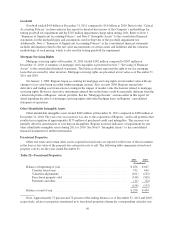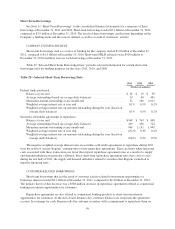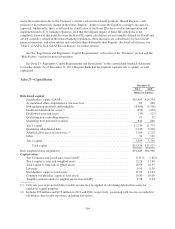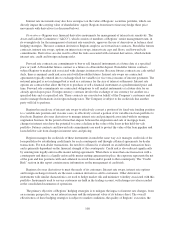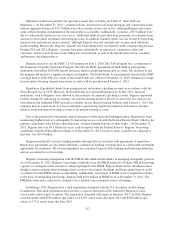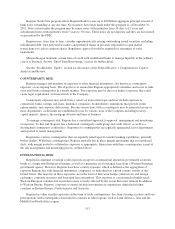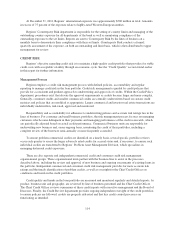Regions Bank 2011 Annual Report Download - page 130
Download and view the complete annual report
Please find page 130 of the 2011 Regions Bank annual report below. You can navigate through the pages in the report by either clicking on the pages listed below, or by using the keyword search tool below to find specific information within the annual report.Management believes the most significant potential impact of deflation on financial results relates to
Regions’ ability to maintain a high amount of capital to cushion against future losses. In addition, the Company
can utilize certain risk management tools to help it maintain its balance sheet strength even if a deflationary
scenario were to develop.
RISK MANAGEMENT
Risk identification and risk management are key elements in the overall management of Regions.
Management believes the primary risk exposures are market risk, liquidity risk, counterparty risk, international
risk and credit risk. Market risk is the price and earnings variability (mainly reductions) arising from adverse
changes in 1) the fair values of financial instruments due to changes in interest rates, exchange rates, commodity
prices, equity prices or the credit quality of debt securities and/or 2) the impact to net interest income based on
changes in interest rates and the associated impact on prepayments. Regions’ market risk is made up of three
components: interest rate risk, prepayment risk, and capital markets and brokerage-related risks (primarily
associated with Morgan Keegan). Interest rate risk is the risk to net interest income due to the impact of
movements in interest rates. Prepayment risk is the risk that borrowers may repay their loans or other debt earlier
than at their stated maturities. The Company, primarily through Morgan Keegan, is also subject to various
market-related risks associated with its brokerage and market-related activities. Liquidity risk relates to Regions’
ability to fund present and future obligations. Counterparty risk represents the risk that a counterparty will not
comply with its contractual obligations. International risk, or country exposure, is defined as the aggregation of
exposure Regions has with financial institutions, companies, or individuals in a given country outside of the
United States. Credit risk represents the risk that parties indebted to Regions fail to perform as contractually
obligated. Regions’ primary credit risk arises from the possibility that borrowers may not be able to repay loans,
and to a lesser extent, the failure of securities issuers and counterparties to perform as contractually required.
Management follows a formal policy to evaluate and document the key risks facing each line of business,
how those risks can be controlled or mitigated, and how management monitors the controls to ensure that they
are effective. Separate from risk acceptance, there is an independent risk assessment and reporting program. To
ensure that risks within the Company are presented and appropriately addressed, the Board has designated a Risk
Committee of outside directors. The Risk Committee’s focus is on Regions’ overall risk profile, and the
committee receives reports from the Company’s management quarterly. Additionally, Regions’ Internal Audit
Division performs ongoing, independent reviews of the risk management process which are reported to the Audit
Committee of the Board of Directors.
Some of the more significant processes used to manage and control these and other risks are described in the
remainder of this report. External factors beyond management’s control may result in losses despite risk
management efforts.
MARKET RISK—INTEREST RATE RISK
Regions’ primary market risk is interest rate risk, including uncertainty with respect to absolute interest rate
levels as well as uncertainty with respect to relative interest rate levels, which is impacted by both the shape and
the slope of the various yield curves that affect the financial products and services that the Company offers. To
quantify this risk, Regions measures the change in its net interest income in various interest rate scenarios
compared to a base case scenario. Net interest income sensitivity is a useful short-term indicator of Regions’
interest rate risk.
Sensitivity Measurement—Financial simulation models are Regions’ primary tools used to measure interest
rate exposure. Using a wide range of sophisticated simulation techniques provides management with extensive
information on the potential impact to net interest income caused by changes in interest rates. Models are
structured to simulate cash flows and accrual characteristics of Regions’ balance sheet. Assumptions are made
about the direction and volatility of interest rates, the slope of the yield curve, and the changing composition of
the balance sheet that result from both strategic plans and from customer behavior. Among the assumptions are
106


